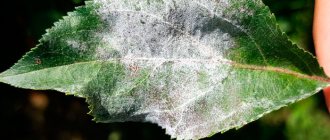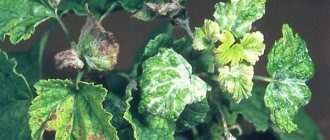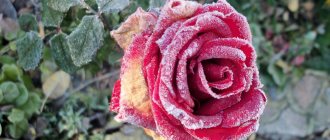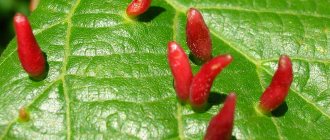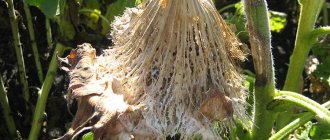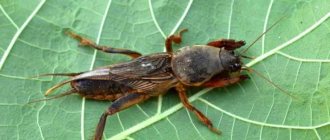Vegetable growing » Cucumbers
1
3253
Article rating
Kira Stoletova
Downy mildew of cucumbers, or downy mildew, is a dangerous disease that can destroy all plantings and spreads very quickly. The disease is caused by a fungus-like organism that parasitizes exclusively on pumpkin crops. It is difficult to treat; in most cases, the affected plants die. The main methods of prevention are treating seeds before planting, regulating humidity and following the rules of agricultural technology.
Downy mildew of cucumbers and methods of combating it
Milk and iodine
Iodine is an antiseptic that, when interacting with water, releases active oxygen. It is destructive for fungal diseases.
Milk contains microelements beneficial for the plant, and its protein foam is able to cover the surface, preventing fungi and bacteria from penetrating deep into the leaf.
To prepare a solution for treatment, you need to mix 10 drops of 5% iodine with 1 liter of skim milk or whey. Dilute the resulting mixture in 9 liters of water, let the solution stand for a couple of minutes so that the ingredients combine well. Pour into a spray bottle, spray the foliage on both sides and the entire length of the stems.
It is better to treat bushes in the evening in calm weather. Once every 10 days or after heavy rain, the procedure must be repeated.
Treatment of peronosporosis on cucumbers with biological products during fruiting
Treatment of powdery mildew with chemicals in July-August, when active fruiting is in full swing, is not recommended. Each drug has a certain waiting period. During this period, it is not recommended to eat vegetables. They can also be used when the cucumbers are still in the setting phase, and then after that the cucumbers must be washed very thoroughly.
When cucumbers are already in full swing, biological products or folk remedies can help. They can be used both for preventive purposes and for treatment. These methods are broad-spectrum, so they will help protect plants from such scourges as Fusarium wilt, root rot, etc. Regular use (once every 7-10 days) of biological products is extremely effective. And besides, you will maintain your health. What can I use?
- Fitosporin . 1-2 tbsp. l. The working solution is diluted in 10 liters of water. The first preventive spraying is carried out when the plant still has 3-5 leaves. Subsequent treatments are carried out at intervals of 10-15 days. Carry out at least 3 treatments. More details about Fitosporin.
- Glyocladin . Its tablets are embedded in the top layer of soil. The fungal culture Trichoderma, which is contained in the preparation, enters the cells of the pathogen and dissolves them, blocking its further spread. Add no more than 2 tablets to the well.
- Gamair . Dilute in a proportion of 10 tablets per 10 liters of water. Consumption of working solution – 10 l per 100 sq. m. The first treatment is carried out during the flowering period or the beginning of fruiting. Carry out at least 2 treatments with an interval of 15 days.
- Trichoderma Veride 471 . Dilute at the rate of 30 g per 10 liters of water. The consumption of the working solution is 10 l per 100 sq. m. Spraying is carried out during the flowering period, then at the beginning of fruiting.
If downy mildew has already spread greatly on cucumbers, you can no longer do without chemicals - fungicides.
Onion peel
The husk contains phytoncides that have an antimicrobial effect and microelements that increase the immunity of plants and their ability to photosynthesize. You need to prepare the husks in bags, after drying them completely.
To prepare the solution, pour 200-300 g of dry onion peels into a large metal container and add 10 liters of water. Place on the fire, bring to a boil, cover with a lid and remove from the stove. Leave for 2 days and then start spraying.
Treatment can be carried out once a month or more often if it rains constantly.
Measures to combat powdery mildew with folk remedies
As a preventive measure, it is worth using drugs that are safe for both humans and the environment. First of all, they are intended to increase the plant’s immunity by improving the soil, suppressing pathogens and propagating beneficial microflora. Such preparations include those containing the trichoderma fungus - Trichodermin, Trichoplant, Trichoflor and the like. It is very useful to spray the soil and the plants themselves with AKCH tea.
There are no special restrictions on the use of the above drugs; these are not chemicals or fertilizers. But they improve the condition of the soil, which leads to an increase in plant immunity. If it so happens that powdery mildew does appear, you cannot do without treatment.
There are quite effective and inexpensive folk remedies for treating the disease. One of these is whey. The serum based recipe is as follows:
- Dissolve 1 liter of whey in 10 liters of water.
- Add 30-40 ml of ammonia to the resulting solution. Ammonia is sold in pharmacies; in our city, a bottle costs from 20 rubles.
Ammonia reduces the acidity of the serum, which plants do not really like; in addition, ammonium lactate is formed, which in turn is very useful and creates a favorable environment for the development of microflora competitive to powdery mildew - Bacillus subtilis and Trichoderma, which in turn suppress the fungus of the disease.
Before treatment, remove diseased leaves. Use the resulting solution to pour the cucumbers under the root at the rate of 0.5-1 liter per bush, as well as the area near the trunk. Spray the entire plant generously, from the ground to the crown. This solution can also be fed to plants in the spring, at the beginning of the growing season, when they need nitrogen.
This recipe is not only medicinal, it also acts as a comprehensive nutrition. Whey contains phosphorus, potassium and other biologically active substances.
Another effective folk remedy is regular baking soda. Recipe:
- Soda – 3-4 tbsp.
- Laundry soap – 50g. Soap acts as an adhesive.
- Water – 10 liters.
Dilute the soap in warm water until liquid, pour into a large container and dilute with 10 liters of water. Add and dissolve soda. Remove affected leaves and spray all remaining leaves in the morning or evening. After a week, repeat the treatment. Treatments are carried out until all signs of the disease disappear. Spraying should be carried out sparingly; the soda solution has an adverse effect on the condition of the soil. One of the advantages of this treatment is safety for humans; it can be carried out during the period of mass fruiting.
Mullein infusion
Treating the bushes with an infusion of manure will help prevent the occurrence of downy mildew, and the drops that fall on the soil will serve as additional fertilizer for the cucumbers.
Mix 1 kg of mullein and 3 liters of water. Close the container and place in a warm place for 3-4 days. During this time, the manure will ferment and antifungal substances will become active. Strain the infusion and add room temperature water to it so that the total volume is 8 liters, stir.
Spray the leaves with the resulting infusion on both sides at the rate of 5 liters per 5 sq.m. It is better to do this early in the morning or after sunset to avoid burning the foliage. Treat the bushes once every 2 weeks throughout the growing season.
Symptoms of the disease
This is a dangerous fungal disease caused by the fungi Erysiphe cichoracearum and Sphaerotheca fuliginea. The infection is transmitted from diseased plants to healthy bushes by spores. The disease is usually easy to diagnose. If you look closely at the photo of cucumber leaves affected by this disease, it will seem that someone was walking along the aisle and accidentally spilled a handful of flour.
Photo. Cucumber affected by the disease: on the left – the initial stage, on the right – a heavily affected plant.
The mycelium of the fungus, similar to flour, constantly multiplies and after a short time the entire leaf blade is covered with it. The further fate of the affected leaf is to turn yellow, wither, and die. These are the signs of what this fungal disease looks like on cucumbers.
Since infection most often comes from the soil, the lower leaves are the first to be affected, especially those touching the surface of the soil. After a short period of time, if powdery mildew on cucumbers is not treated, the disease rushes upward, affecting the following parts of the bush:
- leaves;
- petioles;
- flowers;
- ovary;
- fruit.
More than half of the crop on the affected bushes becomes unusable, and the surviving cucumbers become defective in appearance and lose their taste.
Description and causes of the disease
Vegetable growers know that this fungal disease usually occurs at the start of the summer season, when optimal conditions for its development are created - high humidity and low positive temperatures.
The fungus develops best at a humidity of 50% and an air temperature of 20-27 °C. To protect your plantings from this insidious disease, you need to know why this fungal disease appears on cucumbers. Below is a list of the main reasons:
- too much nitrogen fertilizer was applied;
- little potassium and phosphorus in the soil;
- wide range of temperature fluctuations;
- the weather was stormy for a long time;
- violation of the irrigation regime;
- using cold water for irrigation, especially in cool weather;
- Crop rotation is not maintained - cucumbers are grown in one place for several years;
- thickened crops;
- drafts and lack of light (in the greenhouse).
Observations of the severity of symptoms in summer should be carried out at least at 3-4 day intervals.
To protect the crop from fungal attack, it is necessary to apply appropriate measures to combat powdery mildew. The list of these measures includes prevention to prevent the spread of the disease and timely treatment using chemicals and folk remedies.
What is the difference between true powdery mildew and downy mildew?
Cucumbers can be affected by true MR and false (FMR) or downy mildew. These diseases are caused by different pathogenic fungi and have some similarities and differences.
Below is a table comparing diseases.
| Signs | ||
| Symptoms | The upper part of the leaves is covered with small whitish spots, the bottom of the leaf blade is covered with a white layer of mycelium. | Oily brown spots appear on the top of the leaves, and a gray coating appears on the back of the leaf blade. |
| Under what conditions does the fungus reproduce? | High air humidity, sudden temperature changes. | Prolonged cold, stormy weather. |
| Sources of infection | The infection spreads to bushes from soil and water. The wind can carry the spores. | Through undisinfected seeds, plant remains, water. |
This MR spreads very quickly on greenhouse cucumbers. The fungal pathogen spends the winter in the soil or in plant debris. Cucumber bushes can become infected at any stage of development, but most often at the zenith of summer. Outbreaks usually occur near the entrance to the greenhouse, in waterlogged areas of open ground.
Important! Immediately after infection, it is impossible to discern the symptoms of the disease. They appear after 5 days, when the incubation period has passed.
With downy mildew, yellow-green specks appear on the surface of the leaves, and bluish-purple mycelium appears on the opposite side of the leaf. The incubation period of this fungus lasts 3 days. The disease affects the stems and leaves without spreading to the fruits. The first symptoms of the disease are found on the upper leaves, and after a week the disease covers the entire bush.
Based on the abundance of symptoms, the source of infection can be assumed:
- if the infection of the bushes is focal, then the infection came from outside;
- when the disease is observed on all bushes at once, the infection occurred due to undisinfected seeds.
Urea solution
Urea helps fight pests and fungal diseases, including powdery mildew.
The solution for foliar treatment is prepared at the rate of 1 g per 1 liter of water. Pour it into a spray bottle with a fine nozzle and spray the cucumber bushes. Large-drop spraying will not work, since almost the entire solution will drain to the ground, and the stains of nitrogen salts remaining on the leaves will cause necrosis of the tissues of the bush.
When fighting powdery mildew, bushes need to be treated 3 times with an interval of 5 days.
Preventive actions
The first thing you need to do to protect cucumbers from powdery mildew is to remove all the leaves and stems of the plant in the fall and dig up the ground. The second is to disinfect greenhouses and garden tools. For better protection, you can treat the soil with biological fungicides.
The soil in the greenhouse needs to be dug up and watered with disinfectants.
What are the recommended preventive measures against powdery mildew:
- do not plant cucumbers in a place where crops of the Pumpkin family grew;
- Before planting, soak the seeds in a solution of potassium permanganate for half an hour;
- annually replace the top layer of soil in the greenhouse;
- do not overuse fertilizing with nitrogen;
- Maintain the temperature in the greenhouse at least 20 degrees and ensure good ventilation;
- do not water the bushes with ice water;
- use biological products for prevention.
Bordeaux liquid
It adheres well to plant foliage, is suitable for the prevention and treatment of peronosporosis, and is safe for bees pollinating cucumber bushes.
To treat downy mildew, prepare a 3% solution. For prevention, a 1% solution is suitable, which is prepared from 10 liters of water, 100 g of copper sulfate and 100 g of quicklime.
You can treat the bushes with a warm solution early in the morning and in the evening in dry weather, avoiding getting the drug on the soil near the roots. For 10 square meters, 2 liters of the prepared mixture is enough.
What does powdery mildew look like on cucumbers?
It is easy to recognize the disease on cucumbers by the following characteristic signs:
- small white or red spots on the lower leaf blades;
- plaque on petioles, stems;
- the size of the spots increases and merges;
- leaf blades, shoots in white dust;
- spots change color to brown;
- the plates curl and dry quickly;
- the fruits become deformed and crack;
- the shoots dry out and darken.
Fungal spores look like small brown balls. The humid microclimate in the greenhouse creates the most favorable conditions for its development. Therefore, cucumbers there are more susceptible to disease. The fungus usually overwinters in vegetation torn out in the fall. With the onset of warmth in the spring, it awakens, attaches itself to the surface of the leaf blades, and drinks their juice. Its spores germinate rapidly, the higher the humidity, the faster - 3-7 days.
Downy mildew (downy mildew) is caused by the fungus Pseudoperonospora cubensis. It is characterized by yellow-green, uneven spots with veins on the leaves. Then they become oily and brown. There is a white-violet coating on the bottom of the plates. After a few days, the leaves dry out.
If control measures are not taken, the bushes will quickly die.
Reasons for the appearance of fungus: rainy, foggy weather, temperature fluctuations, dense plantings, soil with a high nitrogen content, frequent watering with cold liquid, uncollected weeds in the beds.
"Fitosporin-M"
This drug is prepared as a ready-made liquid, paste or powder. Most often, powder is used to process cucumbers.
The solution is prepared from the drug mixed with water in a ratio of 1 to 2. The finished mixture must be infused for 3 hours to activate the bacteria. Only rainwater or well water is suitable, since chlorine from the city water supply destroys all beneficial bacteria in the solution.
Leaves should be treated every 14 days, and during the rainy season once a week.
Causes of the disease and risk factors
Downy mildew infection and its development are most active during periods with moderate temperatures (15-20°C) during the day and cool nights. Fog, frequent rain and dew are all favorable factors for infection. Warm temperatures (30-35°C), on the contrary, slow down the development of the disease.
In addition to weather conditions, the following factors can “push” the pathogen to take active action:
- Top watering of cucumbers when water hits the leaves.
- Watering with cold water.
- High planting density.
- Lots of weeds.
- When growing cucumbers in a greenhouse, there is a lack of good air ventilation.
In greenhouses and hotbeds, downy mildew on cucumbers develops rapidly, so treatment should be started as quickly as possible. Remember that days and even hours count. In open ground, the infection is often less active, but under favorable weather conditions it can also destroy plantings in a few days.
Here are the consequences of peronosporosis of cucumbers without treatment:
Varieties resistant to disease
The earliest varieties of cucumbers resistant to powdery mildew:
- Thumb Boy;
- Masha;
- Gherkin Diva.
Early ripening cucumbers:
- Martin;
- Nightingale;
- Princess.
Medium varieties of cucumbers:
- Pasadena;
- Natalie;
- Octopus;
- Goosebumps;
- Phoenix Plus;
- Lancaster.
Late cucumbers:
- Darling;
- fontanel;
- Leandro.
Symptoms of powdery mildew
- It is easy to recognize the parasitic fungus - it is a white coating on the leaves, stems and flowers. At first, the spots appear on the outside of the leaf, and a little later they appear on the inside. In the absence of measures to treat dew, spots affect the entire green surface, leading to drying out of this part.
- Then the leaf curls, followed by drying out and dying. Due to the fact that the parasite blocks the access of nutrients to the leaf, the entire plant dies, which leads to a significant reduction in yield.
- The plants most susceptible to disease are those located near the greenhouse window or near the door.
Periods of development of powdery mildew
Fungal spores awaken with the onset of the warm season, namely when the temperature reaches a regular temperature of +16 degrees. Gardeners need to be especially careful during this period and take preventive measures to prevent the onset of the disease. First, the leaf is covered with a thin layer of plaque, which gradually grows and increases. When the air temperature becomes +18 -+25°C, the mycelium begins to spray spores for further reproduction. It should be noted that this occurs at any degree of humidity and even in dry climates.
The end of August and beginning of September is the season for preparing the mushroom for wintering. Brown fruiting bodies in the form of dots are formed. This way the mushroom will overwinter so that with the onset of warmth it will wake up again.
Each stage is treatable, but experts recommend not to delay, but to take preventive measures or destroy the pest in the early stages.

